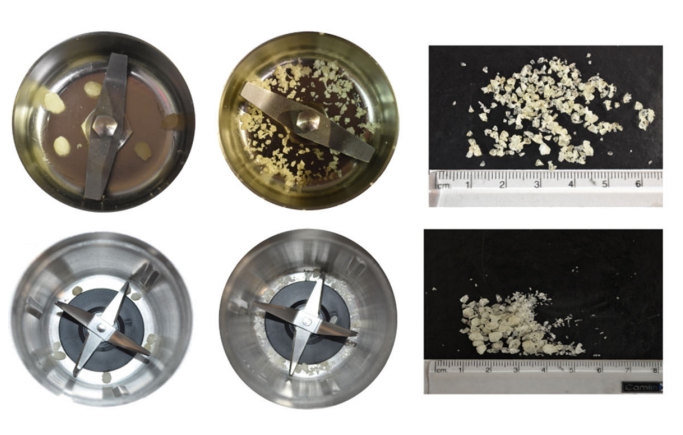According to new research, 3D printed tablets could deter opioid abusers from misusing pharmaceuticals. A team from St. John’s University, New York, designed and tested egg-shaped thermoplastic shapes that make it difficult to misuse strong prescription drugs.
These egg-shaped tablets, dubbed “egglets”, were developed and assessed by Doctors Pavan Kumar Nukala, Siddhant Palekar, Manali Patki and Ketan Patel. The 3D printed pills passed the majority of tests for abuse deterrent opioids as described in FDA guidance.
Abuse deterrent opioids are altered to make them harder to take recreationally. The researchers opted for an egg-shaped template, reminiscent of the hard outer shell of an egg. They felt that this shape would deter drug abusers from attempting to tamper with the pills.
The egglets were made of drug-loaded polymeric filaments, prepared using hot melt extrusion (HME). These were converted into solid dosage form, using a desktop FDM 3D printer.

The dangers of opioid abuse
The effects of opioid misuse vary, depending on how they are taken. Opioids can be ingested, inhaled or injected, and the highest number of overdose deaths are caused by inhaling or injecting. Prescribed medication is often designed to be ingested for this reason. Snorting can destroy tissue in the nose or mouth, and injection carries the risk of blood-borne infections.
If a drug appears to be too difficult to abuse, drug misusers may be less likely to attempt recreational use. Research on this is mixed, with findings from the National Opioid Medication Abuse Deterrence (NOMAD) study concluding that tamper-resistant oxycodone reduced rates of injection among people who inject drugs. In addition, there was no evidence that these users switched to other opioids. A May 2018 study in The Journal of Anaesthesiology concluded that ADFs “will likely benefit a relatively small subset of patients who are tempted to transition from oral to more intense opioid”.
Meanwhile, overall rates of opioid addiction are in an increasing trend, according to the latest statistics from the Centers for Disease Control and Prevention, published this month.
Abuse deterrent pharmaceuticals
One way to reduce death by overdose is to make it harder for abusers to take too much of the drug at once. Ingesting a pill is a slow, labor-intensive way of taking opioids, since swallowing many pills takes a while.
Abusers prefer to turn them into solutions for injection or powder for snorting, so they can take more of the substance in one sitting. This increases the risk of overdose. Snorting is one of the most common routes of abuse, because it is the most convenient.
To combat this, pharmaceutical companies can produce Abuse Deterrent Formulations (ADFs). ADFs are medicines that are difficult to change in shape, size or state. They cannot be easily crushed or dissolved in water. According to the report, ADFs have the potential to “substantially reduce” opioid abuse, at significantly lower cost to the health care system. Currently, medical costs in the U.S. from opioid misuse are about $78.5 billion a year.
The egglet results
To meet FDA specifications, ADF pills must be extremely hard, with a crush resistance of more than 50kg. This makes it difficult for anyone to crush the medicine with conventional household items. The egglets passed the crushing test, withstanding the required 50kg of force.
If the pills are cut or blended instead, a further measure is to make sure that the pieces are too large for snorting, and cannot be made any smaller. To be snorted effectively, the ground-up particles must be less than 1mm. The researchers tested this by putting the egglets in a commercial coffee grinder. The crushed egglet pieces were 80% larger than 1mm, and therefore unsuitable to inhale.

The final test for the egglet was to see how easily it would dissolve in water. If the opioid can be dissolved in liquid, it can be loaded into a needle and injected intravenously.
After sitting in water for 15 minutes, the egglet showed no change in shape or size. As a result, the surrounding water held less than 15% of the drug – too small a quantity to provide a satisfying outcome for a would-be opioid abuser.
3D printing in drug delivery
The use of 3D printers in medicine is becoming common enough that there is now a dedicated medical journal for 3D printing in medicine. However, in terms of drug delivery systems, researchers have focused on novel ways of releasing medicine, rather than using 3D printing in conventional applications, such as ADF medicines.
A recent example is the first 3D printed drug-eluting mouthguard for personalized drug therapy, tested by the Institute of Bioengineering and Nanotechnology in Singapore and the University of Montreal in Canada.
The egglet research is one of only a few applications of 3D printing in tackling drug abuse. Another comes from a much more radical source; last July, Dr. Michael Laufer, founder anarchist biohacking network Four Thieves Vinegar Collective, debuted the Apothecary Mircolab at Hackers On Planet Earth Conference in New York, which lets users synthesize homemade medication for opiate overdoses, among other controversial uses.
“Abuse Deterrent Immediate Release Egg-Shaped Tablet (Egglets) Using 3D Printing Technology: Quality by Design to Optimize Drug Release and Extraction” is published online in AAPS PharmSciTech journal.
Are you interested in the work of St. John’s University? You can nominate them, or any relevant organisation, in the 2019 Printing Industry Awards.
Join us! Our free 3D Printing Industry newsletter contains all the latest news on 3D printing. You can also follow us on Twitter and like us on Facebook.
Have you considered a new career in additive manufacturing? Visit 3D Printing Jobs to browse our selection of careers postings.
Featured image shows St John’s University, Manhattan Campus. Photo via St John’s University.



